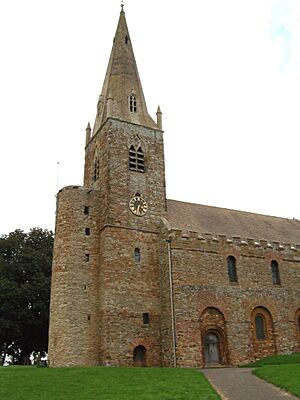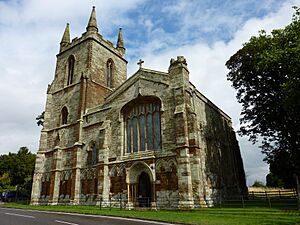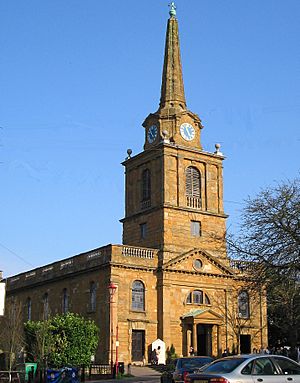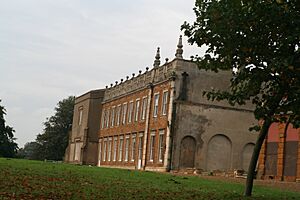List of monastic houses in Northamptonshire facts for kids
Monastic houses were special places where groups of people, called monks or nuns, lived together. They dedicated their lives to prayer, study, and work, following strict rules set by their religious orders. These houses, like abbeys and priories, were very important in medieval England. They often served as centers for learning, charity, and farming.
In Northamptonshire, England, many monastic houses were built over hundreds of years. They played a big role in the local communities before they were mostly closed down in the 1530s during a time known as the Dissolution of the Monasteries.
Alien houses are included, as are smaller establishments such as cells and notable monastic granges (particularly those with resident monks), and also camerae of the military orders of monks (Knights Templars and Knights Hospitaller). Monastic hospitals are included where they had the status or function of an abbey, priory, friary or preceptor/commandery.
- Abbreviations and key
| Symbol | Status |
|---|---|
| None | Ruins |
| * | Current monastic function |
| + | Current non-monastic ecclesiastic function (including remains incorporated into later structure) |
| ^ | Current non-ecclesiastic function (including remains incorporated into later structure) or redundant intact structure |
| $ | Remains limited to earthworks etc. |
| # | No identifiable trace of the monastic foundation remains |
| ~ | Exact site of monastic foundation unknown |
| ≈ | Identification ambiguous or confused |
Locations with names in italics indicate possible duplication (misidentification with another location) or non-existent foundations (either erroneous reference or proposed foundation never implemented) or ecclesiastical establishments with a monastic name but lacking actual monastic connection.
| EH | English Heritage |
| LT | Landmark Trust |
| NT | National Trust |
Contents
Early Monasteries in Northamptonshire
Some of the earliest monastic sites in Northamptonshire date back to Anglo-Saxon times. These were often simple communities that were sometimes destroyed during Viking raids.
Brixworth Abbey
Brixworth Abbey was a Saxon monastery, possibly for Benedictine monks, founded after 675. It was a daughter church of Medehamstede (now Peterborough Cathedral). Sadly, it was likely destroyed around 870 during raids by the Danes. Today, the church building is known as All Saints' Church, Brixworth and is used by the local community.
Castor Priory
Castor Priory was a home for Saxon nuns, founded before 664–5. Like Brixworth, it was destroyed by the Danes around 870, or possibly in 1010.
Weedon Monastery
Weedon Monastery was founded around 680 by St Werburgh, possibly on the site of an old Anglo-Saxon royal palace. This monastery, likely for Benedictine nuns, was also destroyed by the Danes in 870.
Priories and Abbeys for Monks
Many different orders of monks established homes in Northamptonshire. Each order had its own rules and way of life.
Canons Ashby Priory
Canons Ashby Priory was founded between 1147 and 1151 by Stephen de Leye for the Augustinian Canons Regular. These canons were priests who lived in a community under a strict rule, similar to monks. The priory was closed in 1536. Part of its church is still used today.
Chacombe Priory
Chacombe Priory was another home for Augustinian Canons Regular, founded between 1216 and 1272. It was dissolved in 1536. A house named 'Chacombe Priory' was built on the original site in the 17th century.
Daventry Priory
Daventry Priory was home to Cluniac monks. It was first founded at Preston Capes around 1090 and then moved to Daventry in 1107–8. For a long time, it was an alien house, meaning it was dependent on a larger monastery in France called La Charité. It became independent in 1405 and was closed in 1525. The Holy Cross Church, which was once connected to the priory, was rebuilt in the 19th century.
Pipewell Abbey
Pipewell Abbey was a Cistercian monastery founded on September 13, 1143. Cistercian monks were known for their simple lives and often lived in remote areas. The abbey was closed in 1538 and was mostly in ruins by 1548. Its stones were used to build other structures.
Sulby Abbey
Sulby Abbey was founded in 1155 for the Premonstratensian Canons. This order was similar to Augustinians. The abbey was dissolved in 1538.
Priories and Abbeys for Nuns
Nuns also had their own communities where they lived and prayed.
Catesby Priory
Catesby Priory was initially for Benedictine nuns, founded around 1175. Later, it became a home for Cistercian nuns. It was closed in 1536. A house was built on the site in the 16th century, but it was demolished in 1863.
Delapré Abbey
Delapré Abbey was a significant home for Cluniac nuns, founded around 1145 by Simon de St Liz II. It was dedicated to St Mary. The abbey was dissolved on December 15, 1538.
Fotheringhay Nunnery
Fotheringhay Nunnery was a short-lived community for Cluniac nuns, founded around 1141. The nuns moved to Delapré around 1145. Later, a secular college was founded on the site in 1411.
Sewardsley Priory
Sewardsley Priory was a home for Cistercian nuns, founded between 1216 and 1272. It was closed in 1538.
Monastic Houses in Northampton
The town of Northampton itself was home to several monastic communities, including different orders of friars. Friars were different from monks because they often lived among the people and begged for their support, rather than staying within a monastery's walls.
Northampton Abbey
Northampton Abbey was founded around 1145-50 for the Augustinian Canons Regular. It was known as the Abbey Church of Saint James. The abbey was dissolved in August 1538, and a housing estate now stands on its former site.
Northampton Friaries
Northampton had several friaries:
- Austin Friars: These were Augustinian Friars, founded between 1275 and 1290. They were closed in 1538.
- Blackfriars: These were Dominican Friars, founded before 1233. They were also dissolved in 1538.
- Friars of the Sack: This was a smaller order of friars, founded before 1271, but they left the site before 1303.
- Greyfriars: These were Franciscan Friars, first founded in 1226 and then moved to a new site around 1235. They were dissolved in 1538.
- Whitefriars: These were Carmelite Friars, founded before 1265. They were closed in 1538.
Northampton — St Andrew's Priory
Northampton — St Andrew's Priory was a home for Cluniac monks, founded between 1093 and 1100. Like Daventry, it was an alien house dependent on a French monastery until it became independent in 1405. It was dissolved in 1538.
Other Notable Monastic Sites
Dingley Preceptory
Dingley Preceptory was a base for the Knights Hospitallers, a military religious order, founded before 1154. They were dissolved in 1540.
Preston Capes Priory
Preston Capes Priory was an early home for Cluniac monks, founded around 1090. This community later moved to Daventry in 1107–8.
Images for kids
See also












